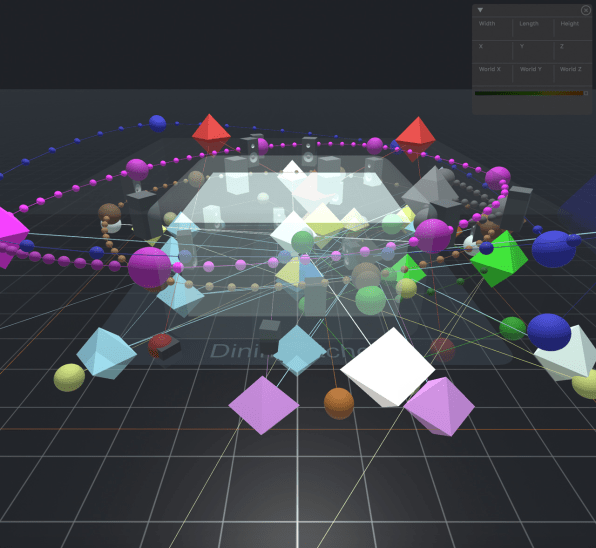More offices and public spaces are using sound design to influence behavior and feelings. This is what it sounds like.

I’m on the 20th floor of an office building on Wall Street. One of the offices inside is equipped with about a dozen speakers, some sitting on plinths, others mounted on the ceiling. Aric Marshall, of audio software company Spatial, is leading a demonstration of a new soundscape designed for the workplace. Holding his phone, he says “Just listen,” and touches the screen. I ready myself to hear the soundscape come out through the speakers, but just the opposite happens. The sound I hadn’t processed turns off, plunging the room in a cold, uncomfortable, almost metallic silence. Without me realizing it, a soundscape had been playing all along—in this case, a muted, almost imperceptible pitter-patter of rain falling on the roof of a wooden cabin—coating the concrete office with a sort of soft, sonic balm.
For the longest time, architecture was designed for the eye, leaving other senses by the wayside. In recent years, however, architects and designers have started to consider how certain spaces might sound, smell, or even feel to the touch. Now, our senses are being stimulated, so much so that signature scents and bespoke soundscape have become part of business and marketing strategies for a growing number of companies, from Abercrombie & Fitch to Mastercard.

Made Music Studio has been shaping the way places sound for 20 years, most recently in downtown Dallas, where they decked out a 2.4-acre public/private space surrounding AT&T’s global headquarters with 130 speakers emitting soundtracks that match the flow of the day (think ambient music, watery noises, chimes, and chirps from local birds). Meanwhile, Spatial uses an audio-simulation platform to create immersive experiences with dynamic soundscapes that feel enveloping and fluid, as opposed to coming from a static speaker.
Now, both studios have come together to design a series of sonic ambiances—composed by Made Music Studio using Spatial’s advanced software—that can work in corporate HQs, retail environments, entertainment venues, museums, and elsewhere.
The first is called a “welcome ambiance.” It is measured and slow-paced, and it was designed for office lobbies (hotels lobbies and other arrival spaces would work, too.) The second is a “focus ambiance,” and it’s punctuated by a slowing heartbeat that centers your attention. This could be used near workstations and other quieter spaces where focused productivity is the goal. The third is dubbed “energizing ambiance.” Its upbeat tone is meant for high-energy communal spaces and high-traffic areas like hallways, transport hubs, or even busy retail locations that need to disperse people. (None of these include the pitter-patter of rain that was playing at the beginning.)

A world with constant sound may not resonate with everyone—I was raised with music but even I need silence to reset. The point of a sonic ambiance, however, is that you are not meant to listen to it actively. Unlike a white-noise machine, or a song blasting through a speaker, these sonic compositions are meant to work in the background and quietly enhance your experience. “Masking [noise] is useful, but what we’re trying to do is influence behavior and feelings,” explains Ben Arons, VP and director of music technology at Made Music Studio. “It’s part of the space, like air conditioning. It’s hitting your subconscious and it’s not making you think hard about it.”
In 2018, Made Music Studio conducted a sound study in a real-world office environment with about 180 participants who spent half an hour in work pods equipped with stereo speakers on headrests. Thanks to biometric sensors embedded in the chairs and a set of questionnaires, they found that “well-crafted music and sound” is 16% more calming than typical office ambiance.
Over the past year, landlords and developers have spent resources vying for tenants with unexpected twists and extravagant amenities. “A big aspect of that is that you want those environments to be inviting,” says Calin Pacurariu, co-founder and CEO of Spatial.
Earlier this year, Spatial announced a series of collaborations with healthcare providers like Henry Mayo Newhall Hospital in Santa Clarita, California and Wellstar in Atlanta, to design immersive sound experiences environments to help reduce stress for patients and healthcare workers. In the corporate world, Pacurariu says the company’s now working with top technology companies whose names he can’t divulge. “They’re fundamentally rethinking the future of work in this hybrid environment,” says Pacarariu. “And they see [sound] as a competitive advantage.”
"hear" - Google News
November 19, 2021 at 08:00PM
https://ift.tt/326Y5mW
I got to hear what an office can sound like with the help of 'sonic ambiance' - Fast Company
"hear" - Google News
https://ift.tt/2KTiH6k
https://ift.tt/2Wh3f9n
Bagikan Berita Ini














0 Response to "I got to hear what an office can sound like with the help of 'sonic ambiance' - Fast Company"
Post a Comment